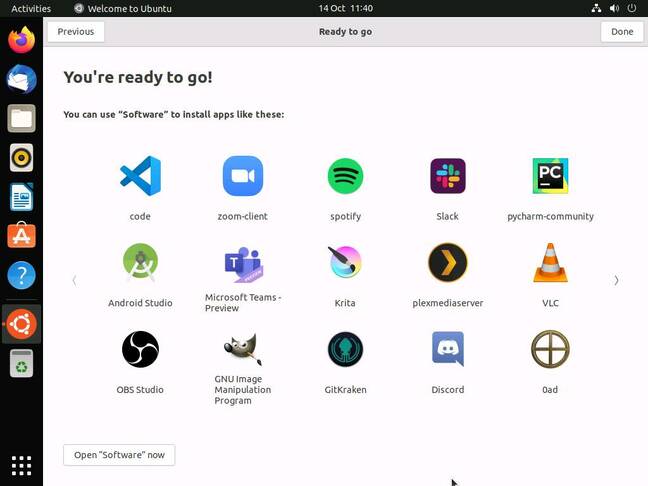This article is more than 1 year old
Ubuntu 21.10 brings GNOME 40 debut and a focus on devs
Also: Why Canonical thinks Ubuntu GUI on Windows 11 matters
Ubuntu 21.10 comes out today, an interim release with nine months of support, and the first to use GNOME 40 for the desktop.
The Ubuntu release cycle delivers a new LTS (Long Term Support) version every two years, the next one being 22.04 in April. This means that 21.10 is a handy preview of features that may not get production use until 22.04.
One of the features highlighted by Canonical is actually a Windows feature. "Windows developers will be delighted with out-of-the-box support for graphical applications on Windows Subsystem for Linux (WSL), which enables users to enjoy Ubuntu desktop applications without modification," said the press release.
The word "developers" suggests that Canonical does not expect this to be something most users will seek out, despite the new status of WSL 2 as a Store app. What is the value of this from Canonical's perspective, bearing in mind that Canonical worked specifically with Microsoft to enable it?
"It's all about inclusivity," Canonical product manager Rob Gibbon told The Register. "We're just fulfilling our mission statement." But how do GUI Linux applications benefit developers on Windows, who mainly target Linux on the server? Gibbon said that easy compilation of applications distributed as source is one advantage. "Maybe you have a scientific application that isn't easy to run on Windows, maybe you can but there's some significant compilation steps. With WSLg we've solved that problem."
The first thing users will notice when firing up Ubuntu desktop (not within Windows) is the GNOME 40 desktop – the first in a new generation built on GTK (GNOME Toolkit) 4. GNOME 41 was released last month, but too late for Ubuntu 21.10. That brings quite a few changes, with Canonical highlighting dynamic workspaces and touchpad gestures.
There is also kernel 5.13, which includes KFENCE (Kernel Electric Fence), a "memory safety error detector" to detect memory errors such as use-after-free. There is also kernel entry point randomisation to defeat some classes of privilege escalation attack. Further, "we've disabled unprivileged BPF (Berkeley Packet Filter) by default in 21.10. Administrators can load BPF programs but users can't, though you can reenable it if you need to," said Gibbon.
- CutefishOS: Unix-y development model? Check. macOS aesthetic? Check (if you like that sort of thing)
- How many Android containers can you fit on your VM?
- More than three years after last release, X.Org Server 21.1.0 RC1 appears
- Ubuntu-on-a-phone folks UBports emit OTA-19, warn some devices face the chop in future
Firefox in this version is included as a Snap, Canonical's packaging system that allows the same package to be used across multiple versions of Linux. "It's consistent across every release of Ubuntu," said Gibbon. Snap is controversial, does Canonical get any pushback from users? "I think the numbers speak for themselves," said Gibbon. "There are 10 million systems actively using Snap every day… Snap is portable across distributions, it's not tied to Ubuntu. You get the benefit of consistency of application and user experience across distributions and platforms and versions."
In this release, said Gibbon, "our focus is on developers. 21.10 is an interim release. Developers can get ready for the next LTS release." Things that might win their attention include the MicroK8s Kubernetes distribution, which is handy both for edge use and for running on a laptop. "There's an add-on ecosystem in MicroK8s that's growing," he told us.
The Linux community is more tolerant of hardware diversity than Microsoft, with its stringent system requirements for Windows 11. "Any architecture or platform to which the Linux kernel, libc, gcc etc. have been ported, and for which an Ubuntu port exists, can run Ubuntu," say the system requirements. That said, Canonical's list of certified hardware is more constrained, featuring only a few vendors. ®
Look out for a review of Ubuntu 21.10 to follow next week.®

